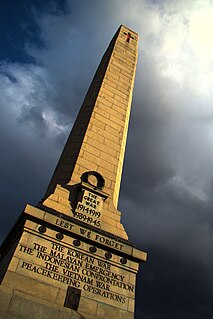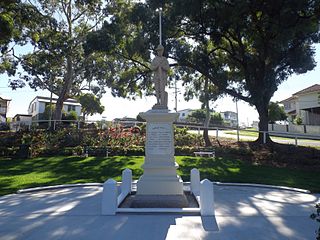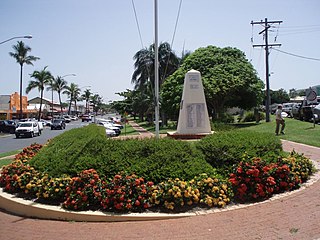
Hobart Cenotaph,, is the main commemorative military monument for the Australian state of Tasmania. It is located in the capital Hobart in a prominent position on the Queens Domain, on a small rise overlooking the city and River Derwent. The Cenotaph sits directly above what was once the location of the Queens Battery.

Cooyar War Memorial is a heritage-listed war memorial in Hack Menkins Park, McDougall Street, Cooyar, Toowoomba Region, Queensland, Australia. The memorial was unveiled on Saturday 14 July 1923 by Arthur Edward Moore. It was designed and produced by R. C. Ziegler and Son and cost £413/10/0, with funds raised by public subscriptions and revenue raised from entertainments. The memorial comprises two pieces, the pedestal surmounted by a digger statue, on which the names of the 25 fallen are recorded, and a smaller plinth which records the names of the 110 local men who served in World War I. It was added to the Queensland Heritage Register on 21 October 1992.

Weeping Mother Memorial is a heritage-listed memorial at Hickey Street, Gatton, Queensland, Australia. It was designed by F. Williams & Co and built in 1922 by the same company. The memorial was added to the Queensland Heritage Register on 21 October 1992.

Beaudesert War Memorial is a heritage-listed memorial at William Street, Beaudesert, Queensland, Australia. It was built from 1919 to 1921. It was added to the Queensland Heritage Register on 21 October 1992.

Ithaca War Memorial and Park is a heritage-listed memorial and park at Enoggera Terrace, Paddington, Queensland, Australia. The memorial was designed and built by Arthur Henry Thurlow between 1921 and 1925. The park was built and designed by Alexander Jolly. It is also known as Alexander Jolly Park. It was added to the Queensland Heritage Register on 21 October 1992.

Manly War Memorial is a heritage-listed memorial at 184 Carlton Terrace, Manly, City of Brisbane, Queensland, Australia. It was built from 1920 to 1921. It is also known as Ferguson Street Reserve, Manly Dam, and Soldiers Memorial Park. It was added to the Queensland Heritage Register on 21 August 1992.

Toowong Memorial Park is a heritage-listed memorial and park at 65 Sylvan Road, Toowong, City of Brisbane, Queensland, Australia. It was designed by George Rae and built c. 1922 by Andrew Lang Petrie Monumental Works. It was added to the Queensland Heritage Register on 4 September 2007.

Oxley War Memorial is a heritage-listed memorial at 1218 Oxley Road, Oxley, Queensland, Australia. It was built in 1920. It is also known as Oxley Memorial Park and Oxley Place. It was added to the Queensland Heritage Register on 4 July 2006.

Gair Park is a heritage-listed park and memorial at 181 Annerley Road, Dutton Park, City of Brisbane, Queensland, Australia. It was built from 1936 onwards. It was added to the Queensland Heritage Register on 5 April 2004.

Booval War Memorial is a heritage-listed memorial at Green Street, Booval, City of Ipswich, Queensland, Australia. It was built in 1919. It was added to the Queensland Heritage Register on 21 October 1992.

The Boer War Memorial is a heritage-listed memorial at Warwick Street, Allora, Southern Downs Region, Queensland, Australia. It was built from 1904 to 1940s. It is also known as Queen's Park and War Memorial Park. It was added to the Queensland Heritage Register on 21 October 1992.

The Eumundi War Memorial Trees is a heritage-listed memorial avenue of trees at Memorial Drive, Eumundi, Sunshine Coast Region, Queensland, Australia. It was built in 1917 onwards. It is also known as Trees in Memorial Drive. It was added to the Queensland Heritage Register on 5 December 1997.

Gympie and Widgee War Memorial Gates is a heritage-listed memorial at Mary Street, Gympie, Gympie Region, Queensland, Australia. The gates provide an entranceway on Mary Street through to the Gympie Memorial Park in Reef Street. The gates were designed by George Rae and built in 1920 by A L Petrie & Son. It was added to the Queensland Heritage Register on 21 October 1992.

Brooweena War Memorial is a heritage-listed memorial at Smith Crescent, Brooweena, Fraser Coast Region, Queensland, Australia. It was built in 1922 by F W Webb. It was added to the Queensland Heritage Register on 21 October 1992.

War Memorial Bridge is a heritage-listed memorial bridge at Brooweena-Woolooga Road, Brooweena, Fraser Coast Region, Queensland, Australia. It was designed by Lawrence Stevens Smith and built in 1921 by Frederick William Webb. It was added to the Queensland Heritage Register on 21 October 1992.

Howard War Memorial is a heritage-listed memorial at William Street, Howard, Fraser Coast Region, Queensland, Australia. It was built in 1921. It was added to the Queensland Heritage Register on 21 October 1992.

Bundaberg War Nurses Memorial is a heritage-listed memorial at Bourbong Street, Bundaberg West, Bundaberg, Bundaberg Region, Queensland, Australia. It was built in 1949 by Zero Ziegler. It was added to the Queensland Heritage Register on 21 October 1992.

Yeppoon War Memorial is a heritage-listed memorial avenue of trees in Normanby Street, James Street and Anzac Parade, Yeppoon, Shire of Livingstone, Queensland, Australia. It was built in 1921 and 1984. It was added to the Queensland Heritage Register on 23 July 1999.

World War I Cenotaph is a heritage-listed memorial at Jubliee Park, Alfred Street, Mackay, Mackay Region, Queensland, Australia. It was designed by Stephen Harvey and built from 1928 to 1929 by Melrose & Fenwick. It is also known as Mackay War Memorial and Jubilee Park. It was added to the Queensland Heritage Register on 21 August 1992.






























